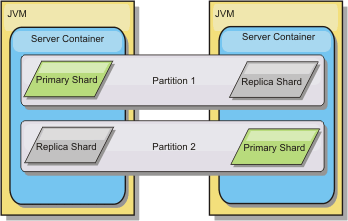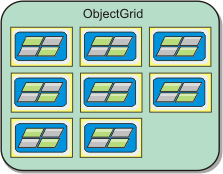Product overview > Cache > Caching architecture
Container servers, partitions, and shards
Container server
The container server stores application data for the data grid. This data is generally broken into partitions, which are hosted across multiple container servers.
Each container server hosts a subset of the complete data.
A JVM can host one or more container servers and each container server can host multiple shards.
Partitions
Partitions host a subset of the data in the grid. WebSphere eXtreme Scale automatically places multiple partitions in a single container server and spreads the partitions out as more container servers become available.
Choose the number of partitions carefully before final deployment because the number of partitions cannot be changed dynamically. A hash mechanism is used to locate partitions in the network and WXS cannot rehash the entire data set after it has been deployed. As a general rule, you can overestimate the number of partitions
Shards
Shards are instances of partitions and have one of two roles: primary or replica. The primary shard and its replicas make up the physical manifestation of the partition. Every partition has several shards that each host all of the data contained in that partition. One shard is the primary, and the others are replicas, which are redundant copies of the data in the primary shard. A primary shard is the only partition instance that allows transactions to write to the cache. A replica shard is a "mirrored" instance of the partition. It receives updates synchronously or asynchronously from the primary shard. The replica shard only allows transactions to read from the cache. Replicas are never hosted in the same container server as the primary and are not normally hosted on the same machine as the primary.
ObjectGrid
To increase the availability of the data, or increase persistence guarantees, replicate the data. However, replication adds cost to the transaction and trades performance in return for availability.
With WXS, you can control the cost as both synchronous and asynchronous replication is supported, as well as hybrid replication models using both synchronous and asynchronous replication modes. A synchronous replica shard receives updates as part of the transaction of the primary shard to guarantee data consistency. A synchronous replica can double the response time because the transaction has to commit on both the primary and the synchronous replica before the transaction is complete. An asynchronous replica shard receives updates after the transaction commits to limit impact on performance, but introduces the possibility of data loss as the asynchronous replica can be several transactions behind the primary.
Parent topic:
Cache architecture: Maps, containers, clients, and catalogs
Related concepts
Maps
Clients
Catalog service
Cache topology: In-memory and distributed caching
Related tasks
Configure catalog and container servers



